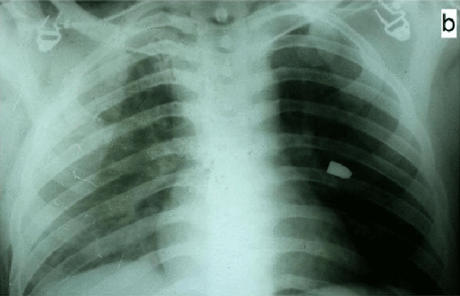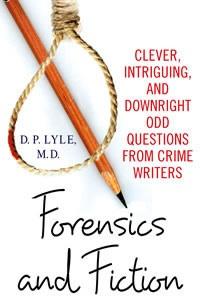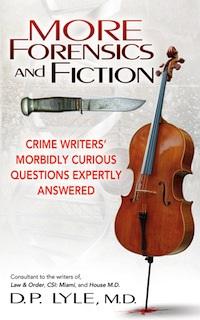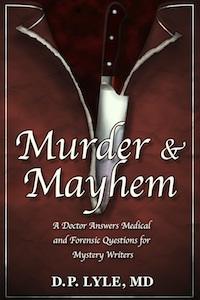 Criminal Mischief: Episode #18: Gunshot To The Chest
Criminal Mischief: Episode #18: Gunshot To The Chest LISTEN: https://soundcloud.com/authorsontheair/gswtochest
PAST SHOWS: http://www.dplylemd.com/criminal-mischief.html
SHOW NOTES: http://www.dplylemd.com/criminal-mischief-notes/18-gunshot-to-the-chest.html
Gunshot wounds (GSWs) come in many flavors and those to the chest can be particularly dicey. Yet, a chest GSW can be a minor flesh wound, a major traumatic event with significant damage, or deadly. If you have a character who suffers such an injury, this podcast is for you.
Here are a few interesting questions about chest GSWs:
Could a Person Survive a Gunshot to the Chest in the 1880s?Q: My scenario is set in 1880. A man in his early 20s is shot in the back by a rifle. He loses a lot of blood and is found a couple of hours later unconscious. Could he survive and if so how long would it take him it recuperate? Also, would it be possible to bring him to consciousness long enough for another man to get him into a buggy. Is any part of this scenario possible?
A: Everything about your scenario works. A gunshot wound (GSW) to the chest can kill in minutes, hours, days, or not at all. The victim would be in pain and may cough and sputter and may even cough up some blood. He could probably walk or crawl and maybe even fight and run if necessary. Painful, but possible. He would likely be consciousness so could even help get himself into the wagon.
If all goes well, he should be better and gingerly up and around in a week or two. He would be fully recovered in 6 to 8 weeks.
After surviving the initial GSW, the greatest risk to his life would a secondary wound infection. Since no antibiotics were available at that time, the death rate was very high-40 to 80 percent-for wound infections. But, if he did not develop an infection, he would heal up completely.
How Is A Gunshot To The Chest Treated?Q: I have a few questions regarding a gunshot wound that my poor character will be sustaining later on in my story. Supposing it's a fairly small caliber bullet (typical handgun fare, not buckshot or anything) and it hits near the heart without puncturing anything important, how long might his recovery time be? He's a strong, kinda-healthy guy in his thirties, although he drinks a fair amount and used to smoke. He'll be rushed to a high-quality hospital immediately and receive the best care throughout recovery...what's his outlook? When will he be allowed to go home, if all goes well? How long before he's healed to normal?When will it be safe for him to walk around, drive, have sex, etc.?
A: In your story, what happens to your shooting victim depends upon what injuries he received. A gunshot wound (GSW to docs and cops) can be a minor flesh wound or can be immediately deadly or anywhere in between. It all depends on the caliber and speed of the bullet and the exact structures it hits. A shot to the heart may kill instantly or not. The victim could die in a few minutes or survive for days or could recover completely with proper medical care and surgery. It's highly variable but ask any surgeon or ER doctor and they will tell you that it's hard to kill someone with a gun. Even with a shot or two to the chest.
A small caliber and slow speed bullet-such as those fired by .22 and .25 caliber weapons-are less likely to kill than are heavier loads and higher velocity bullets such as .38, .357, or .45 caliber bullets, particularly if they are propelled by a magnum load-such as a .357 magnum or a .44 magnum. Also, the type of bullet makes a difference. Jacketed or coated bullets penetrate more while hollow point or soft lead bullets penetrate less but do more wide-spread damage as the bullet deforms on impact.
All that is nice but the bottom line is that whatever happens, happens. That is, a small, slow bullet may kill and a large, fast one may not. Any bullet may simply embed in the chest wall or strike a rib and never enter the chest. Or it could enter the heart and kill quickly. Or it could puncture a lung. The victim here would cough some blood, be very short of breath, and could die from bleeding into the lungs-basically drowning in their own blood. Or the lung could collapse and again cause pain and shortness of breath. But we have two lungs and unless the GSWs are to both lungs and both lungs collapse the person would be able to breathe, speak, even run away, call for help, or fight off the attacker. Whatever happens, happens.
This is good for fiction writers. It means you can craft your scene any way you want and it will work. He could suffer a simple flesh wound and have pain, shortness or breathe, and be very angry. He could have a lung injury and have the above symptoms plus be very short of breathe and cough blood.If the bleeding was severe or if both lungs were injured he could become very weak, dizzy, and slip into shock. Here his blood pressure would be very low and with the injury to his lungs the oxygen content of his blood would dip to very low levels and he would lose consciousness as you want. This could happen in a very few minutes or an hour later, depending upon the rapidity of blood loss and the degree of injury to the lungs.
Once rescued, the paramedics would probably place an endotracheal (ET) tube into his lungs to help with breathing, start an IV to giver IV fluids, and transport him to the hospital immediately. He would then be seen by a trauma surgeon or chest surgeon and immediately undergo surgery to remove the bullets (if possible) and to repair the damaged lung or whatever else was injured. He could recover quickly without complications and go home in a week, rest there for a couple of weeks, return to part-time work for a few weeks and be full speed by 3 to 4 months. Or he could have one of any number of complications and die. Or be permanently disabled, etc. It all depends upon the nature of Injuries, the treatment, and luck.
What Does a Close-range Gun Shot to the Chest Look Like?Q: I have a question regarding gunshot wounds. In my latest mystery, a man and a woman, my heroine, struggle for a gun. It goes off, hitting the man in the chest. I want the man to live, but be temporarily incapacitated and need hospital care, so if the chest isn't the best location, other suggestions are welcome. What would the gunshot wound likely look like before and after the man's shirt was removed? Would there be a lot of bleeding where my heroine would take his shirt off and stuff it over the wound?
A: A gunshot wound (GSW) to the chest would work well. For it to be quickly fatal, the bullet would have to damage the heart or the aorta or another major blood vessel, such as the main pulmonary (lung) arteries. Under these circumstances, bleeding into the chest, the lungs,and around the heart would likely be extensive and death could be almost instantaneous or in a very few minutes. He could survive even these injuries, but this would require quick and aggressive treatment, including emergent surgery, and a pile of luck.
If the bullet entered the lung, the victim could die from severe bleeding into the lung and basically drowning in his own blood. Or not. He could survive such an injury and would then require surgery to remove the bullet, control the bleeding within the lung, and repair the lung itself. This would require a couple of hours of surgery, a week in the hospital, and a couple of months to recover fully.
The bullet could simply embed in the chest wall and never enter the chest cavity. It could bounce off the sternum (breast bone) or a rib and deflect out of the chest, into the soft tissues of the chest wall, or downward into the abdomen. Once a bullet strikes bone, it can be deflected in almost any direction. Sometimes full-body X-rays are required to find the bullet. If the bullet simply embedded beneath his skin or against a rib or the sternum, he would require a minor surgical procedure to remove the bullet and debride (clean-up) the wound. He would be hospitalized for only 2 to 3 days and would go home on antibiotics and basic wound care.
Close-range, but not direct muzzle contact, wounds typically have a small central entry wound, a black halo called an abrasion collar, and often an area of charring around the wound. The charring comes from the hot gases that exit the barrel with the bullet. In addition, there is often tattooing, which is a speckled pattern around the entry wound. This is from the soot and unburned powder that follows the bullet out of the muzzle and embeds (tattoos) into the skin. The spread of this pattern depends upon how close the muzzle is to the entry point, If it over about 3 feet, then no tattooing or charring will occur.
In your scenario, the victim's shirt would likely collect the soot and heat so that it would be charred and "tattooed," rather than the victim's skin. So, the shirt would show an entry hole, charring, and blood. Once the victim's shirt was removed, the entry wound likely be a simple hole without any charring or tattooing, since the shirt would have collected this material and absorbed most of the heat. The wound could bleed a lot, a little, or almost none. It depends upon how many of the blood vessels that course through the skin and muscles are damaged.
Yes, her initial efforts should be the application of pressure over the wound to control bleeding until the paramedics arrive.
For more fun questions check out my Q&A books:

FORENSICS and FICTION: http://www.dplylemd.com/book-details/forensics-fiction.html

MORE FORENSICS and FICTION: http://www.dplylemd.com/book-details/more-forensics-and-fiction.html

MURDER AND MAYHEM: http://www.dplylemd.com/book-details/murder-and-mayhem.html
